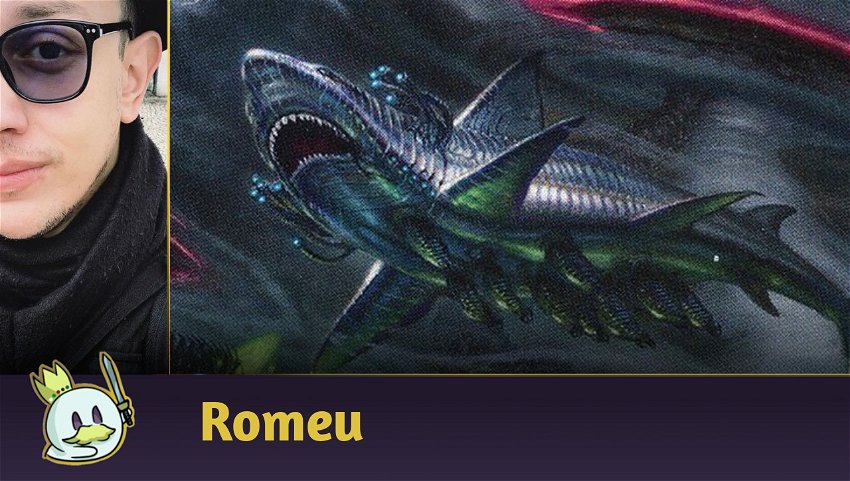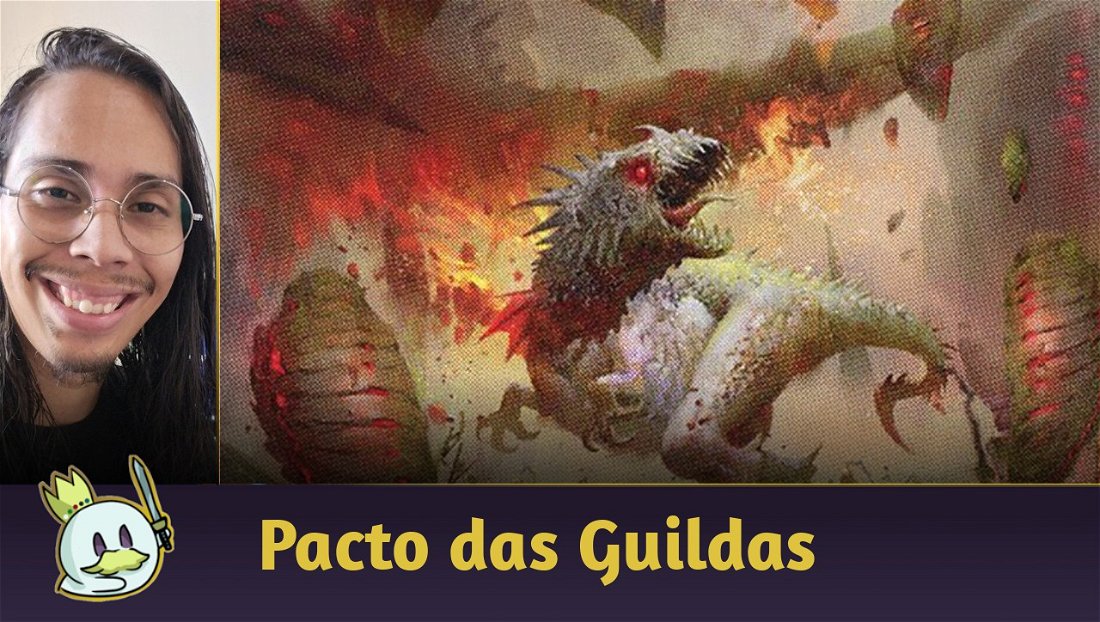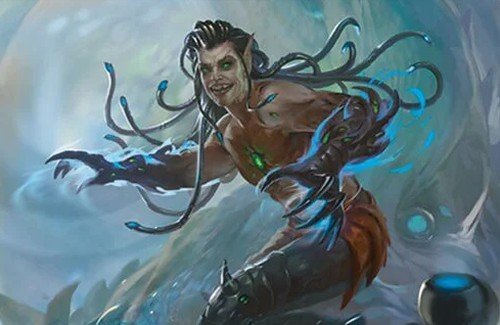The release of March of the Machine brought news to all competitive formats. As we noted in the analysis of the first week of the issue
, Standard was the environment where the new cards had greater relevance.
Among them, an archetype that stood out in the Top 8 of the Challenges was the Dimir Midrange, or Dimir Seedshark. Today, we're going to dive deeper into its strategy, as well as providing a guide against the top Metagame matches.
What is Dimir Seedshark?
Dimir Seedshark is a Midrange deck that seeks to win the game through impactful threats and 2-for-1 trades. Its list follows the pattern of what we see in the Black-Based that are at the top of the Metagame today, with efficient removals and powerful threats, but its difference lies is in the combination of the recently released Chrome Host Seedshark with Tezzeret, Betrayer of Flesh.

Chrome Host Seedshark turns any non-creature spell you cast into a threat by creating an Incubator token with X +1/+1 counters on it, where X is those cards' mana value. This creature helped to reestablish the presence of Control decks in Standard, as it offers a cheap wincondition who is coherent with the other cards in these strategies.
This version seeks to take Incubate to the next level with Tezzeret, Betrayer of Flesh: its passive ability lets you transform one of the tokens into a Phyrexian without paying additional costs, while its +2 ability makes any Incubator a 4/4 creature, which will be even stronger due to the +1/+1 counters.
The Decklist
My decklist above follows the same pattern from the list MJ_23 used to reach seventh place in the Standard Challenge on April 23rd, with some minor changes based on my experience with the archetype.

The most notable change is the exclusion of March of Wretched Sorrow. Despite its interaction with Chrome Host Seedshark, Neon Dynasty's Instant was of little use as an efficient removal against the rest of the format. So, it was replaced by yet another copy of Go for the Throat, and a maindeck Duress.
Maindeck

The heart of our strategy.
Chrome Host Seedshark is a wincondition on its own, grants extra value for every spell we cast, and has an efficient body that survives a large share of removals. Another important point is that the tokens produced by it are artifact creatures. Hence, they bypass Go for the Throat, one of the most famous removals in the Metagame today.
Tezzeret, Betrayer of Flesh is a controversial option. On the one hand, with Seedshark, it transforms our game proposal into an unfair strategy, which accelerates our clock absurdly, and mitigates the damage an opponent's removal would cause by already guaranteeing the transformation of two Incubators.
On the other hand, Tezzeret is the least relevant four-drop in the deck, as it doesn't interact well with the rest of our strategy. Its looting ability, while useful, is underwhelming for its cost, and we have few artifacts to turn into creatures without Seedshark in play.
Perhaps, as the Metagame develops, players will resort to fewer copies of the Planeswalker.

Sheoldred, the Apocalypse is the most important creature in Standard today, as it defines games in its own right. Four copies of her ensure that we always have the option of trying to keep her on the battlefield to build up an advantage over our opponents.
Graveyard Trespasser is a necessary threat and graveyard hate in a Metagame where there are still players who invest in reviving Atraxa, Grand Unifier or Etali, Primal Conqueror. It also offers an efficient clock against fair decks.

Our removals package.
With the addition of Mono Red Aggro in the first week of March of the Machine, Cut Down has become a must-have removal to hold off their aggression, while also addressing other key threats such as Raffine, Scheming Seer.
Go for the Throat is the most efficient black spell to deal with creatures for two mana. In most games, however, you should keep it for the threats that really matter and that Cut Down can't handle, like Sheoldred, the Apocalypse, Atraxa, Grand Unifier or Archfiend of the Dross.

Extending our interactions package, we have Make Disappear as an efficient counterspell. I considered including Disruption Protocol in its place, but like Tezzeret, this spell doesn't interact with the rest of the list, and would rely on Chrome Host Seedshark's tokens to work.
Duress is included as a one-of to play decisive spells. Their number could be amplified if the Magic Arena Metagame becomes less focused on Aggro decks in the coming weeks. In this case, we can replace Cut Down with one more copy.
Blue Sun's Twilight was a card I was skeptical about when building the list. After all, it looked like just another cute interaction with Chrome Host Seedshark. However, as we have a low number of threats, taking control of the opponent's creatures is a viable strategy, especially if we can copy it.

Reckoner Bankbuster is nearly ubiquitous in Standard in any Midrange or Control deck, and it wouldn't be any different in a strategy with Tezzeret, Betrayer of Flesh to transform it.

In addition to a set of all the best dual lands in our colors, we also have some utility lands, such as Otawara, Soaring City and Takenuma, Abandoned Mire, as well as Blast Zone, which doubles as an efficient removal, or even as a late-game sweeper.
Sideboard

Extra graveyard hate.
In Standard today, a dozen archetypes embrace some category of recursion or means of bringing bombs back from the graveyard: The Cruelty of Gix, Invoke Justice, Phoenix Chick, Bloodfeather Phoenix , Razorlash Transmogrant and Bloodthirsty Adversary are some examples.
Therefore, Graveyard Trespasser and Unlicensed Hearse are needed to control these games and delay the opponent's plan long enough. Unlicensed Hearse is an excellent late-game threat that also interacts with Tezzeret, while Trespasser works best on midrange mirrors.

Extra interaction against Midrange and Control.
With the return of Blue-Based and the possibility of early interaction against our main wincondition, we need Duress to broaden our scope of the matchup, while Negate, in addition to protecting our threats, also prevents the opponent from turning the tables with an Invoke Despair or The Cruelty of Gix coming from the top.
Disdainful Stroke is a staple of attrition games, where it deals with Sheoldred, the Apocalypse, Ao, the Dawn Sky, Invoke Despair, Etali, Primal Conqueror and other major threats with a single card.

More board interaction.
Rona's Vortex works as an early-game Tempo play against aggressive decks, and as an efficient removal against punctual threats from Midranges. Its versatility even makes it an option for the Maindeck.
Malicious Malfunction is a direct answer to archetypes that try to play under, and which have recurring threats such as Bloodfeather Phoenix and Grafted Butcher, in addition to dealing with the tokens from Wedding Announcement and Skrelv's Hive.
Mulligan and Postures
There aren't many secrets on how to decide your keep with Dimir Seedshark. At its core, it's still a classic Midrange, with cheap answers and efficient threats.
Against an unknown opponent, your focus should be on having a plan in your starting hand. That is, there is no point in having a very responsive hand, with counterspells and removals, if you don't have a threat to present a clock. Likewise, an overly aggressive hand will take too many turns to do something, leaving you very vulnerable to an Aggro race.
After the first game, when we already know what the opponent's deck is, we need to consider our keep based on how we can interact with their game plan. This requires a good understanding of the format and how the match plays out for both sides, and extensive practice to understand what works against each opponent.
Sideboard Guide
Rakdos Reanimator
IN

OUT

The biggest problem in the matchup against Rakdos or Grixis Reanimator is that their fair game plan is too efficient. Therefore, we need to worry about preventing Atraxa from entering the battlefield, while we also need to prepare for an attrition matchup.
Our best plan in Game 1 is to try to anticipate what the opponent tries to do, and respond to the main threats while extending the game to the point where we manage to have Chrome Host Seedshark plus protection and/or other impactful magic on the same turn.
The main target of our opponent's spells should be Seedshark and Sheoldred. Take advantage of this to pressure them, and don't risk tapping out just to get hit by an Invoke Despair on the way back.
Our Sideboard is based on the fact the game will drag on. Soon, spells that become conditional late-game or that interact poorly with their threats drop out to make room for others that work better in 1-for-1 trades.
Remember that Unlicensed Hearse can be transformed by Tezzeret, Betrayer of Flesh, and having the vehicle in play feeding from graveyards since the second turn is an easy ticket to late-game victory against careless opponents.
Mono Red Aggro
IN

OUT

Mono Red Aggro remains high in the Magic Arena ranked, both in the classic "go wide" version, with Squee, Dubious Monarch and Thundering Raiju, and in the newer "go big" versions, with Khenra Spellspear and Sword of Once and Future.
Any creature equipped with Sword of Once and Future becomes unstoppable against us. Therefore, we need to prevent this equipment from coming into play, or a threat from remaining on the battlefield when the opponent pays the costs to equip it.
In both cases, our wincondition lies with our creatures, mainly with Sheoldred, the Apocalypse. Tezzeret becomes just a spell with no immediate impact on the game if we don't have Chrome Host Seedshark in play, and we don't have enough time to pay four mana and do nothing in a turn.
Esper Legends
IN

OUT

Esper Legends is the worst match I faced with this deck during my ranked games. They have more efficient creatures, fill the board faster, transition to an attrition plan more easily, and don't open up much space for us to interact well with their creatures, while protecting them well with Skrelv, Defector Mite and Thalia, Guardian of Thraben.
Our best option is to use removals to deal with the most important threats, while Chrome Host Seedshark populates the board with tokens to transform them later on. However, our opponent has ways to deal with our battlefield, and the individual quality of their creatures is much higher than ours.
Mono White Midrange
IN

OUT

Mono White Midrange is a relatively easy matchup, as they tap out frequently to try to cast bombs, and we can take advantage of this to put Seedshark in play and follow a Control stance with our counterspells.
The biggest problem in this match are the moments when the opponent fills the board too quickly for us to handle with targeted removals. Therefore, we include Malicious Malfunction to handle possible early game pressure, or kill the produced tokens by The Eternal Wanderer and Wedding Announcement.
Blue Sun's Twilight should prioritize creatures we can't kill in other ways, like Steel Seraph, but can also be used to take control of tokens for cheap.
Azorius Control
IN

OUT

The biggest problem with this game is that there are varying versions of Azorius Control today: some focusing on Mindsplice Apparatus, others with Chrome Host Seedshark, others focused on Planeswalkers, and so on.
We're disadvantaged against most builds in Game 1 by having eight useless removals in the Maindeck. Therefore, we need a proactive proposal, preferably with Reckoner Bankbuster in the second round, to maintain our resource parity.
I chose to present a more comprehensive post-side plan, with generic answers that go against most variants. We may include Malicious Malfunction instead of Rona's Vortex in versions with Mindsplice Apparatus and White Sun's Twilight, or in variants that rely on Planeswalkers and tokens to win the game.
Our proposal in Game 2 should remain to pressure the opponent and try to dictate the course of the game as soon as possible, given that they have the advantage as the turns pass. If you untap with Chrome Host Seedshark, keep a reactive stance, seeking to respond to what the opponent does with your spells while creating tokens, and transform them at the End Step whenever possible.
Conclusion
Dimir Seedshark is an interesting Best-of-Three strategy, but with some notorious weaknesses, such as relying on certain interactions to work, instead of relying only on the individual value of each card. This makes it less efficient in its category when the pieces don't fit.
On the other hand, it is a new proposal in Standard, and requires further refinement to arrive at an appropriate version. Overall, it's possible that the archetype just integrates other well-known bombs, like Invoke Despair, instead of trying to make combos with Tezzeret, Betrayer of Flesh, or it will always be in the shadow of more efficient strategies today, like Grixis Midrange.
Thanks for reading!













— 评论 0
, 反应 1
成为第一个发表评论的人